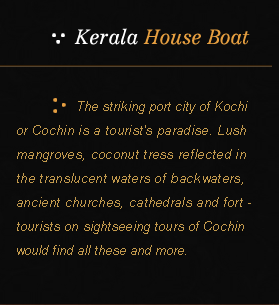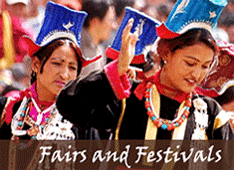Home > India Wildlife Tour > Wildlife & Culture Tour of Nepal

Duration : 09 Days & 08 Nights
Location : Kathmandu – Chitwan – Kathmandu – Pokhra – Kathmandu.
Location : Kathmandu – Chitwan – Kathmandu – Pokhra – Kathmandu.
Day 01
Kathmandu Arrival:
COMPANY REPRESENTATIVE will receive you on arrival at the KATHMANDU AIRPORT and transfer to your hotel.
It is said that king Gun Kamdev founded Kathmandu in the year 723 AD. If you go by the legend, the area was a lake in the past. A Buddhist deity named Manjushri liked the place and wanted habitation there. The Buddhist god then bifurcated the hill to the south and allowed the water to flow out. As the water flowed out, the region became habitable. Of course, this is a Buddhist tradition and is different from the one by Hindus. The origin of the name is still unclear and historians spin new theories every other day according to their whim and fancies. Nevertheless one of the more likely theories is that it was named after Kastha-Mandap ("temple of wood" in Sanskrit). King Laxmi Narashingha Malla commissioned a pagoda carved from the single tree in 1596 and it might be possible that the same pagoda is behind its naming.
Kathmandu is the Mecca of Nepal's traditional culture, arts and cuisines. This is the place for rest and relaxation and don't have hectic lifestyle that has so become part and parcel of metropolitans round the world. The easy-day sightseeing takes you to various historic and artistic temples and monuments. One also enjoys Kathmandu for nightlife, shopping and for the mountain views. The place is famous for handicrafts items that can be bought for mementos and gifts. The embroidered clothes are the other must buy items.
Overnight will be at Kathmandu.
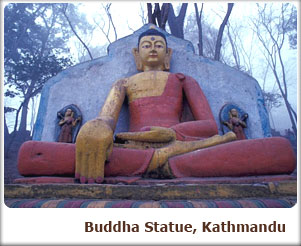 Day 02
Day 02
Kathmandu:
Breakfast will be at hotel.
OPTIONAL: Take an early morning EVEREST FLIGHT for a view of the majestic HIMALAYAS and the MOUNT EVEREST.
Proceed for visits to PASUPATINATH, SWAMBHUNATH & BOUDHNATH.
PASHUPATINATH is not only the holiest Hindu pilgrimage in Nepal but also one of the holiest destinations in the entire world. This temple that has been declared UNESCO Heritage site has been erected and razed to the ground numerous times. There are lingam images of Shiva along with statues and temples dedicated to other deities in the complex. There is historical evidence that a temple dedicated to Shiva existed at this site in AD 879. What happened of that temple, nobody knows. However, King Bhupatindra Malla built the present temple in the year 1697. The present temple is the subtle work of architecture with its gold-plated roof, be-jeweled doors, flowered motifs and woodcarvings of the finest quality. The square-shaped pagoda like temple, which is built on a single platform of 24 meters in height, stands in the middle of an open courtyard. The entrance of the temple is from all the four sides and is decorated by gold-gilt doors. Inside the temple there is a narrow walk engulfing the sanctum from where one can have closer view of Shivlinga.
Pashupatinath area is regarded as one of the most important places of pilgrimages for the followers of Hinduism in the entire world. Thousands of devotees come to pay homage to Pashupatinath every day. On special occasions like Ekadasi, Sankranti, Maha Shivaratri, Teej Akshaya, Rakhi, Grahana (eclipse), Poornima (Full moon day) people congregate here in far greater number.
The Buddhist temple of SWAYAMBHUNATH, situated on the top of a hill, west of Kathmandu, is one of the most popular, holy and instantly recognizable symbols of Nepal. The temple is colloquially known as the 'monkey temple' because of the large tribe of roving monkeys who guard the temple.
Swayambhunath Stupa is a golden spire crowning a conical wooded hill. It is the most ancient and enigmatic of all the holy shrines in Kathmandu Valley. It has a lofty white dome and a glittering golden spire that are visible from all sides of the valley. Historical records found on a stone inscription give evidence that the stupa was already an important Buddhist pilgrimage destination by the 5th century A.D. i.e. before the coming of Buddhism in the valley.
BOUDDHNATH STUPA is not only the largest Stupa in Nepal but also one of the largest Stupas in entire Asia. Since ages Bouddhnath has been a citadel and center of attraction of Tibetan Lama Buddhism in Nepal. This white pagoda that stands 36 meters on its feet falls in the way of the ancient trade route between Bihar and Tibet and that is why it was the focal point for the caravans that passed either ways. Tibetan merchants and hermits have rested and offered prayers here for many centuries. Travelers like Fa'Hein have traversed the same route.
The area around the Bouddhnath Stupa is a feast to the eyes typical to all Tibetan Buddhist sites. Colorful Thangkas and flags mark the whole area. It is also a shopper's paradise in Kathmandu. Tibetan jewelry, hand-woven carpets, masks, and Khukri knives are some of the must buy items in this market.
Smaller Stupas are located at the base. Gompa monasteries, curio shops, and restaurants surround Bouddhanath. Conveniently situated restaurants with rooftop patios provide good food and excellent views of Bouddhanath.
Overnight will be at Kathmandu.
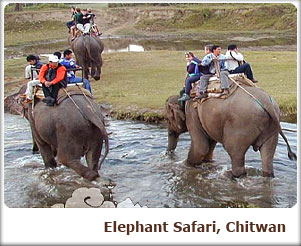 Day 03
Day 03
Kathmandu – Chitwan:
By Road 185Kms/05hrs
Today you will leave Kathmandu and drive to the south of Nepal to the Royal Chitwan National park. This National Park is situated near the Indian Nepal border. The area of the National Park covers around 950 km.
Royal Chitwan National Park stands as a successful testimony of nature conservation in South Asia. This is the first national park of Nepal established in 1973 to preserve a unique ecosystem significantly valuable to the whole world. The park covering a pristine area of 932 sq. km is situated in the subtropical inner Terai lowlands of southern central part of Nepal. The park has gained much wider recognition in the world when UNESCO included this area on the list of World Heritage Site in 1984.
Formerly, the Chitwan valley was well known for big game and was exclusively managed as a hunting reserve for the Rana Prime Ministers and their guests until 1950. In 1963, the area south of Rapti was demarcated as a rhinoceros sanctuary. In 1970, His late Majesty King Mahendra had approved in principle the creation of Royal Chitwan National Park.
There are more than 43 species of mammals in the park. The park is especially renowned for the protection of the endangered one-horned rhinoceros, tiger, and gharial crocodile along with many other common species of wild animals. The estimated population of endangered species of animals such as gaur, wild elephant, four horned antelope, striped hyena, pangolin, gangetic dolphin, monitor lizard and python, etc. Some of the other animals found in the park are samber, chital, hog deer, barking deer, sloth bear, common leopard, ratel, palm civet, wild dog, langur, rhesus monkey, etc.
There are over 450 species of birds in the park. Among the endangered birds found in the park are Bengal florican, giant hornbill, lesser florican, black stork and white stork, Few of the common birds seen are peafowl, red jungle fowl, and different species of egrets, herons, kingfishers, flycatchers and woodpeckers. The best time for bird watching is March and December. More than 45 species of amphibians and reptiles occur in the park and some of which are marsh mugger crocodile, cobra, green pit viper and various species of frogs and tortoises. The park is actively engaged in the scientific studies of several species of wild flora and fauna.
Overnight will be at Chitwan.
Day 04
Chitwan:
Breakfast will be at the hotel.
Explore the National Park on the back of elephants.
In the early morning there are more than 450 different bird species that make this National Park full of life.
In the afternoon take a ride in Canoe on the Narayani river and after that explore the park more intensively in the accompany of a forest officer.
Overnight will be at Chitwan.
Day 05
Chitwan – Kathmandu:
By Road 185Kms/05hrs
Breakfast will be at the hotel.
Proceed to Kathmandu. Reach and check into the hotel.
Relax and then visit THE DURBAR SQUARE.
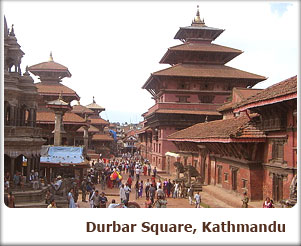 THE DURBAR SQUARE is same to Nepal as Tianmen Square is to Beijing. The place has been listed in the UNESCO world heritage site. Durbar Square is the focal point of religious and social activities in Kathmandu Old City. This place comprises palaces, temples, shrines, statues and courtyards built between the 12th and 18th centuries by the ancient kings of Nepal. The Durbar square is the subtle amalgamation of old and new. The elaborately carved architectural features and curving roofs are night stays for beggars and tourists. Priests and monks who jostle along the crowd to attract a possible client accompany them.
THE DURBAR SQUARE is same to Nepal as Tianmen Square is to Beijing. The place has been listed in the UNESCO world heritage site. Durbar Square is the focal point of religious and social activities in Kathmandu Old City. This place comprises palaces, temples, shrines, statues and courtyards built between the 12th and 18th centuries by the ancient kings of Nepal. The Durbar square is the subtle amalgamation of old and new. The elaborately carved architectural features and curving roofs are night stays for beggars and tourists. Priests and monks who jostle along the crowd to attract a possible client accompany them.
Two ferocious looking stone lions guard the gates of Old Royal Palace that was abandoned by the monarchs in the late 18th century. The campus contains a number of courtyards and several museums. There is a plaque that is set in the palace walls which is said to be 400 years old. The inscriptions written on the plaque is in 15 different languages. On the other side of the square is the Kastha Mandap temple that is said to have bore its name to Kathmandu. The unique feature of this temple is that it has been constructed of wood out of a single tree. The structure is an open pavilion that is topped by a pyramidal tower. It is purportedly the Valley's oldest building.
Kathmandu Durbar square, also known as Hanuman Dhoka Durbar, used to be the residence of the Nepali royal family and administrators. The palace became a public attraction when the monarchs shifted to the newly build Narayanhity Palace. The Hanuman Dhoka Durbar lies in the heart of the city. It consists of huge Royal Palace with different temples dating from the 15th to the 18th century. This palace is named after Hanuman, a Hindu deity and a stone statue of Hanuman is placed right next to the main entrance.
In the evening enjoy a local dance program with an authentic NEPALI DINNER at the cultural centre.
Overnight will be at Kathmandu.
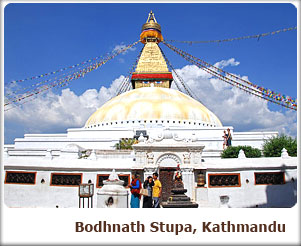 Day 06
Day 06
Kathmandu:
Proceed for a full day visit of PATAN & BHAKTAPUR after breakfast.
PATAN is protected by UNISCO world heritage site. Patan is the second largest city in the valley. It is some time referred to as Lalitpur, which means city of beauty. Patan has long Buddhist history and the four corners of the city are marked by stupas. Patan’s central Durbar square is absolutely packed with temples. It an architectural feast with a far greater concentration of temples per sq meter than in Kathmandu or Bhaktipur. Numerous other temples widely diverse style as well as many Buddhist monasteries are scattered around this fascinating town. The Patan Durbar square is a concentrated mass of temples, undoubtedly the most visually stunning display of Newari architecture to be seen in Nepal. There is also many others numerous temples are Krishna, Bhimsen, Taleju bell, Bhai Dega and others many temples gives you more experience about Nepali people faith and respect on religion. All the temples are decorated by numerous arts and architecture. The Patan also offers you Newari people culture and them life style.
The ancient city is located on the southern bank of the holy Bagmati River and is approximately five kilometers south-east of the capital. The whole city is full of Buddhist monuments and Hindu temples with fine bronze gateways, marvelous statues, guardian deities and magnificent carvings including stone carving, metal carving and wood carving. Well noted for its gorgeous craftsmen and metal workers, it is often known as the city of superb artists. The majority of the citizens follow the Buddhist faith.
Located about 20 km east of Kathmandu in the Kathmandu Valley, BHAKTAPUR is known as the 'City of Devotees', the 'City of Culture', the 'Living Heritage', and 'Nepal's Cultural Gem'. It is one of the 3 royal cities in the Kathmandu Valley. The others are Kathmandu, the capital of Nepal, and Patan.
Bhaktapur is filled with monuments, most terra-cotta with carved wood columns, palaces and temples with elaborate carvings, gilded roofs, and open courtyards. The city is dotted with pagodas and religious shrines.
Lying along the ancient trade route between India and Tibet, Bhaktapur is surrounded by mountains and provides a magnificent view of the Himalayas.
Overnight will be at Kathmandu.
Day 07
Kathmandu – Pokhra:
By Local Flight
Breakfast will be at the hotel.
Take local flight for Pokhara. Reach and check into the hotel.
Pokhara is situated at about 827 meter from sea level. The magnificent city is located about 200 kilometers west of Kathmandu and can be reached both by aircraft as well as bus. The journey duration is 35 minutes and 5 hours respectively. As far as adventure trips are concerned, Pokhara is the next destination after Kathmandu. Pokhara is often called the enchanting Himalayan valley with a heart of major actions and adventures.
Surrounded by beautiful snow-capped mountains with a magnificent lake of crystal-clear pure Himalayan water; the Pokhra is a dream come true. An all-year round pleasing weather and friendly inhabitants will greet you with smile and leave you with the most unforgettable moments in your life. So pack up your bag, load your camera, and get ready for Pokhara experience!
Among the attractions, nothing is as majestic as the Fewa (or Phewa) Lake. The lake is 1.5-kilometer long and second largest in Nepal. Fewa Lake offers an excellent view of the mountains and their reflections in the water. This picturesque place is a hot favorite among the honeymoon couple. There are as many as 8 different lakes in Pokhra and apart from Fewa Lake, Begnas and Rupa Lakes are the most serene. Both these lakes are located about 15 km from Pokhara and are ideal places for relaxation, boating and fishing.
Another spectacular sight in Pokhara is the sight of Annapurna range. This magnificent range stretching from west to east looks beautiful in the glittering sunlight. Apart from that Seti Gandaki and Seti Gorge are other two important places to visit in Pokhara. The Seti Gandaki flows right through the city at places it runs completely underground. The best view of the river can be seen from the top of the Seti Gorge. Then you have Mahendra cave that is located about 10km north from downtown Pokhara. It is a natural site located across the Seti River.
Pokhara is also known for its Newari and Tibetan artifacts. No trip to Pokhara can be complete without buying Newari handicrafts items. Don't forget to buy Tibetan carpet as well. The Newars have heavily contributed to the culture of Pokhra and that can be witnessed in its magnificent cuisines. Newari food is a must eat in Pokhra.
Overnight will be at Pokhra.
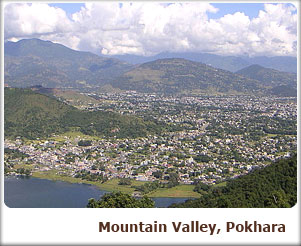 Day 08
Day 08
Pokhra:
We start our day with the early morning visit to Sarangkot for the fabulous sunrise. After the spectacular sunrise, we drive back to our hotel to start our remaining activities for the day with the breakfast at the hotel.
Today, we take you to the famous Devi’s Fall (also known as Devin’s or David’s) locally known as Patale Chhango (Hell’s Fall), an awesome waterfall lying about 2 km south-west of Pokhra Airport on the highway to Tansen. Legend has it that a trekker (Devin, David…) was washed away by the Pardi Khola and mysteriously disappeared down into an underground passage beneath the fall.
Bindhyabasubu Temple at the old bazaar, Seti Gandaki, the boisterous river running completely underground at the places, Mahendra cave (House of Bats), the natures’ wonder at Pokhra & Pokhra Museum.
After lunch, start exploring the city by driving to the Begnas Lake & Rupa Lake located 15 Km from Pokhra divided by a forested hillock called Panchabhaiya Danda, offering the perfect nature retreat with their relative seclusion.
Overnight will be at Pokhra.
Day 09
Pokhra – Kathmandu – Departure:
By Local Flight
Enjoy breakfast in the hotel.
Proceed to Kathmandu. Reach and enjoy last minute shopping.
As per your INTERNATIONAL FLIGHT TIMINGS you’ll be transferred to the airport to take your flight back home with sweet memories of NEPAL TOUR
...........................................................................TOUR ENDS...........................................................................
INCLUSIONS:
Kathmandu Arrival:
COMPANY REPRESENTATIVE will receive you on arrival at the KATHMANDU AIRPORT and transfer to your hotel.
It is said that king Gun Kamdev founded Kathmandu in the year 723 AD. If you go by the legend, the area was a lake in the past. A Buddhist deity named Manjushri liked the place and wanted habitation there. The Buddhist god then bifurcated the hill to the south and allowed the water to flow out. As the water flowed out, the region became habitable. Of course, this is a Buddhist tradition and is different from the one by Hindus. The origin of the name is still unclear and historians spin new theories every other day according to their whim and fancies. Nevertheless one of the more likely theories is that it was named after Kastha-Mandap ("temple of wood" in Sanskrit). King Laxmi Narashingha Malla commissioned a pagoda carved from the single tree in 1596 and it might be possible that the same pagoda is behind its naming.
Kathmandu is the Mecca of Nepal's traditional culture, arts and cuisines. This is the place for rest and relaxation and don't have hectic lifestyle that has so become part and parcel of metropolitans round the world. The easy-day sightseeing takes you to various historic and artistic temples and monuments. One also enjoys Kathmandu for nightlife, shopping and for the mountain views. The place is famous for handicrafts items that can be bought for mementos and gifts. The embroidered clothes are the other must buy items.
Overnight will be at Kathmandu.
 Day 02
Day 02 Kathmandu:
Breakfast will be at hotel.
OPTIONAL: Take an early morning EVEREST FLIGHT for a view of the majestic HIMALAYAS and the MOUNT EVEREST.
Proceed for visits to PASUPATINATH, SWAMBHUNATH & BOUDHNATH.
PASHUPATINATH is not only the holiest Hindu pilgrimage in Nepal but also one of the holiest destinations in the entire world. This temple that has been declared UNESCO Heritage site has been erected and razed to the ground numerous times. There are lingam images of Shiva along with statues and temples dedicated to other deities in the complex. There is historical evidence that a temple dedicated to Shiva existed at this site in AD 879. What happened of that temple, nobody knows. However, King Bhupatindra Malla built the present temple in the year 1697. The present temple is the subtle work of architecture with its gold-plated roof, be-jeweled doors, flowered motifs and woodcarvings of the finest quality. The square-shaped pagoda like temple, which is built on a single platform of 24 meters in height, stands in the middle of an open courtyard. The entrance of the temple is from all the four sides and is decorated by gold-gilt doors. Inside the temple there is a narrow walk engulfing the sanctum from where one can have closer view of Shivlinga.
Pashupatinath area is regarded as one of the most important places of pilgrimages for the followers of Hinduism in the entire world. Thousands of devotees come to pay homage to Pashupatinath every day. On special occasions like Ekadasi, Sankranti, Maha Shivaratri, Teej Akshaya, Rakhi, Grahana (eclipse), Poornima (Full moon day) people congregate here in far greater number.
The Buddhist temple of SWAYAMBHUNATH, situated on the top of a hill, west of Kathmandu, is one of the most popular, holy and instantly recognizable symbols of Nepal. The temple is colloquially known as the 'monkey temple' because of the large tribe of roving monkeys who guard the temple.
Swayambhunath Stupa is a golden spire crowning a conical wooded hill. It is the most ancient and enigmatic of all the holy shrines in Kathmandu Valley. It has a lofty white dome and a glittering golden spire that are visible from all sides of the valley. Historical records found on a stone inscription give evidence that the stupa was already an important Buddhist pilgrimage destination by the 5th century A.D. i.e. before the coming of Buddhism in the valley.
BOUDDHNATH STUPA is not only the largest Stupa in Nepal but also one of the largest Stupas in entire Asia. Since ages Bouddhnath has been a citadel and center of attraction of Tibetan Lama Buddhism in Nepal. This white pagoda that stands 36 meters on its feet falls in the way of the ancient trade route between Bihar and Tibet and that is why it was the focal point for the caravans that passed either ways. Tibetan merchants and hermits have rested and offered prayers here for many centuries. Travelers like Fa'Hein have traversed the same route.
The area around the Bouddhnath Stupa is a feast to the eyes typical to all Tibetan Buddhist sites. Colorful Thangkas and flags mark the whole area. It is also a shopper's paradise in Kathmandu. Tibetan jewelry, hand-woven carpets, masks, and Khukri knives are some of the must buy items in this market.
Smaller Stupas are located at the base. Gompa monasteries, curio shops, and restaurants surround Bouddhanath. Conveniently situated restaurants with rooftop patios provide good food and excellent views of Bouddhanath.
Overnight will be at Kathmandu.
 Day 03
Day 03 Kathmandu – Chitwan:
By Road 185Kms/05hrs
Today you will leave Kathmandu and drive to the south of Nepal to the Royal Chitwan National park. This National Park is situated near the Indian Nepal border. The area of the National Park covers around 950 km.
Royal Chitwan National Park stands as a successful testimony of nature conservation in South Asia. This is the first national park of Nepal established in 1973 to preserve a unique ecosystem significantly valuable to the whole world. The park covering a pristine area of 932 sq. km is situated in the subtropical inner Terai lowlands of southern central part of Nepal. The park has gained much wider recognition in the world when UNESCO included this area on the list of World Heritage Site in 1984.
Formerly, the Chitwan valley was well known for big game and was exclusively managed as a hunting reserve for the Rana Prime Ministers and their guests until 1950. In 1963, the area south of Rapti was demarcated as a rhinoceros sanctuary. In 1970, His late Majesty King Mahendra had approved in principle the creation of Royal Chitwan National Park.
There are more than 43 species of mammals in the park. The park is especially renowned for the protection of the endangered one-horned rhinoceros, tiger, and gharial crocodile along with many other common species of wild animals. The estimated population of endangered species of animals such as gaur, wild elephant, four horned antelope, striped hyena, pangolin, gangetic dolphin, monitor lizard and python, etc. Some of the other animals found in the park are samber, chital, hog deer, barking deer, sloth bear, common leopard, ratel, palm civet, wild dog, langur, rhesus monkey, etc.
There are over 450 species of birds in the park. Among the endangered birds found in the park are Bengal florican, giant hornbill, lesser florican, black stork and white stork, Few of the common birds seen are peafowl, red jungle fowl, and different species of egrets, herons, kingfishers, flycatchers and woodpeckers. The best time for bird watching is March and December. More than 45 species of amphibians and reptiles occur in the park and some of which are marsh mugger crocodile, cobra, green pit viper and various species of frogs and tortoises. The park is actively engaged in the scientific studies of several species of wild flora and fauna.
Overnight will be at Chitwan.
Day 04
Chitwan:
Breakfast will be at the hotel.
Explore the National Park on the back of elephants.
In the early morning there are more than 450 different bird species that make this National Park full of life.
In the afternoon take a ride in Canoe on the Narayani river and after that explore the park more intensively in the accompany of a forest officer.
Overnight will be at Chitwan.
Day 05
Chitwan – Kathmandu:
By Road 185Kms/05hrs
Breakfast will be at the hotel.
Proceed to Kathmandu. Reach and check into the hotel.
Relax and then visit THE DURBAR SQUARE.
 THE DURBAR SQUARE is same to Nepal as Tianmen Square is to Beijing. The place has been listed in the UNESCO world heritage site. Durbar Square is the focal point of religious and social activities in Kathmandu Old City. This place comprises palaces, temples, shrines, statues and courtyards built between the 12th and 18th centuries by the ancient kings of Nepal. The Durbar square is the subtle amalgamation of old and new. The elaborately carved architectural features and curving roofs are night stays for beggars and tourists. Priests and monks who jostle along the crowd to attract a possible client accompany them.
THE DURBAR SQUARE is same to Nepal as Tianmen Square is to Beijing. The place has been listed in the UNESCO world heritage site. Durbar Square is the focal point of religious and social activities in Kathmandu Old City. This place comprises palaces, temples, shrines, statues and courtyards built between the 12th and 18th centuries by the ancient kings of Nepal. The Durbar square is the subtle amalgamation of old and new. The elaborately carved architectural features and curving roofs are night stays for beggars and tourists. Priests and monks who jostle along the crowd to attract a possible client accompany them. Two ferocious looking stone lions guard the gates of Old Royal Palace that was abandoned by the monarchs in the late 18th century. The campus contains a number of courtyards and several museums. There is a plaque that is set in the palace walls which is said to be 400 years old. The inscriptions written on the plaque is in 15 different languages. On the other side of the square is the Kastha Mandap temple that is said to have bore its name to Kathmandu. The unique feature of this temple is that it has been constructed of wood out of a single tree. The structure is an open pavilion that is topped by a pyramidal tower. It is purportedly the Valley's oldest building.
Kathmandu Durbar square, also known as Hanuman Dhoka Durbar, used to be the residence of the Nepali royal family and administrators. The palace became a public attraction when the monarchs shifted to the newly build Narayanhity Palace. The Hanuman Dhoka Durbar lies in the heart of the city. It consists of huge Royal Palace with different temples dating from the 15th to the 18th century. This palace is named after Hanuman, a Hindu deity and a stone statue of Hanuman is placed right next to the main entrance.
In the evening enjoy a local dance program with an authentic NEPALI DINNER at the cultural centre.
Overnight will be at Kathmandu.
 Day 06
Day 06 Kathmandu:
Proceed for a full day visit of PATAN & BHAKTAPUR after breakfast.
PATAN is protected by UNISCO world heritage site. Patan is the second largest city in the valley. It is some time referred to as Lalitpur, which means city of beauty. Patan has long Buddhist history and the four corners of the city are marked by stupas. Patan’s central Durbar square is absolutely packed with temples. It an architectural feast with a far greater concentration of temples per sq meter than in Kathmandu or Bhaktipur. Numerous other temples widely diverse style as well as many Buddhist monasteries are scattered around this fascinating town. The Patan Durbar square is a concentrated mass of temples, undoubtedly the most visually stunning display of Newari architecture to be seen in Nepal. There is also many others numerous temples are Krishna, Bhimsen, Taleju bell, Bhai Dega and others many temples gives you more experience about Nepali people faith and respect on religion. All the temples are decorated by numerous arts and architecture. The Patan also offers you Newari people culture and them life style.
The ancient city is located on the southern bank of the holy Bagmati River and is approximately five kilometers south-east of the capital. The whole city is full of Buddhist monuments and Hindu temples with fine bronze gateways, marvelous statues, guardian deities and magnificent carvings including stone carving, metal carving and wood carving. Well noted for its gorgeous craftsmen and metal workers, it is often known as the city of superb artists. The majority of the citizens follow the Buddhist faith.
Located about 20 km east of Kathmandu in the Kathmandu Valley, BHAKTAPUR is known as the 'City of Devotees', the 'City of Culture', the 'Living Heritage', and 'Nepal's Cultural Gem'. It is one of the 3 royal cities in the Kathmandu Valley. The others are Kathmandu, the capital of Nepal, and Patan.
Bhaktapur is filled with monuments, most terra-cotta with carved wood columns, palaces and temples with elaborate carvings, gilded roofs, and open courtyards. The city is dotted with pagodas and religious shrines.
Lying along the ancient trade route between India and Tibet, Bhaktapur is surrounded by mountains and provides a magnificent view of the Himalayas.
Overnight will be at Kathmandu.
Day 07
Kathmandu – Pokhra:
By Local Flight
Breakfast will be at the hotel.
Take local flight for Pokhara. Reach and check into the hotel.
Pokhara is situated at about 827 meter from sea level. The magnificent city is located about 200 kilometers west of Kathmandu and can be reached both by aircraft as well as bus. The journey duration is 35 minutes and 5 hours respectively. As far as adventure trips are concerned, Pokhara is the next destination after Kathmandu. Pokhara is often called the enchanting Himalayan valley with a heart of major actions and adventures.
Surrounded by beautiful snow-capped mountains with a magnificent lake of crystal-clear pure Himalayan water; the Pokhra is a dream come true. An all-year round pleasing weather and friendly inhabitants will greet you with smile and leave you with the most unforgettable moments in your life. So pack up your bag, load your camera, and get ready for Pokhara experience!
Among the attractions, nothing is as majestic as the Fewa (or Phewa) Lake. The lake is 1.5-kilometer long and second largest in Nepal. Fewa Lake offers an excellent view of the mountains and their reflections in the water. This picturesque place is a hot favorite among the honeymoon couple. There are as many as 8 different lakes in Pokhra and apart from Fewa Lake, Begnas and Rupa Lakes are the most serene. Both these lakes are located about 15 km from Pokhara and are ideal places for relaxation, boating and fishing.
Another spectacular sight in Pokhara is the sight of Annapurna range. This magnificent range stretching from west to east looks beautiful in the glittering sunlight. Apart from that Seti Gandaki and Seti Gorge are other two important places to visit in Pokhara. The Seti Gandaki flows right through the city at places it runs completely underground. The best view of the river can be seen from the top of the Seti Gorge. Then you have Mahendra cave that is located about 10km north from downtown Pokhara. It is a natural site located across the Seti River.
Pokhara is also known for its Newari and Tibetan artifacts. No trip to Pokhara can be complete without buying Newari handicrafts items. Don't forget to buy Tibetan carpet as well. The Newars have heavily contributed to the culture of Pokhra and that can be witnessed in its magnificent cuisines. Newari food is a must eat in Pokhra.
Overnight will be at Pokhra.
 Day 08
Day 08 Pokhra:
We start our day with the early morning visit to Sarangkot for the fabulous sunrise. After the spectacular sunrise, we drive back to our hotel to start our remaining activities for the day with the breakfast at the hotel.
Today, we take you to the famous Devi’s Fall (also known as Devin’s or David’s) locally known as Patale Chhango (Hell’s Fall), an awesome waterfall lying about 2 km south-west of Pokhra Airport on the highway to Tansen. Legend has it that a trekker (Devin, David…) was washed away by the Pardi Khola and mysteriously disappeared down into an underground passage beneath the fall.
Bindhyabasubu Temple at the old bazaar, Seti Gandaki, the boisterous river running completely underground at the places, Mahendra cave (House of Bats), the natures’ wonder at Pokhra & Pokhra Museum.
After lunch, start exploring the city by driving to the Begnas Lake & Rupa Lake located 15 Km from Pokhra divided by a forested hillock called Panchabhaiya Danda, offering the perfect nature retreat with their relative seclusion.
Overnight will be at Pokhra.
Day 09
Pokhra – Kathmandu – Departure:
By Local Flight
Enjoy breakfast in the hotel.
Proceed to Kathmandu. Reach and enjoy last minute shopping.
As per your INTERNATIONAL FLIGHT TIMINGS you’ll be transferred to the airport to take your flight back home with sweet memories of NEPAL TOUR
...........................................................................TOUR ENDS...........................................................................
INCLUSIONS:
- ACCOMODATION AT SUGGESTED HOTELS,
- DAILY BUFFET BREAKFASTS,
- AC VEHICLE WITH THE DRIVER FOR ALL TRANSFERS & SIGHTSEEING AS PER THE ITINERARY,
- MEET AND ASSIST AT THE AIRPORT ON ARRIVAL/DEPARTURE,
- ENGLISH SPEAKING LOCAL GUIDES AT APPLICABLE PLACES
- SAFARIS IN CHITWAN,
- ALL MEALS IN CHITWAN,
- CULTURAL DANCE & DINNER IN KATHMANDU,
- BOAT RIDE IN POKHRA,
- AIRFARE IN ECONOMY CLASS FROM KATHMANDU – POKHRA – KATHMANDU,
- TOLL TAXES, DRIVER ALLOWANCE, PARKING, AND
- ALL APPLICABLE TAXES AND SERVICE CHARGES.
- LUNCHES & DINNERS,
- MONUMENT ENTRANCES,
- CAMERA CHARGES AT THE MONUMENTS,
- PORTER CHARGES,
- TIPS &
- PERSONAL EXPENSES.

